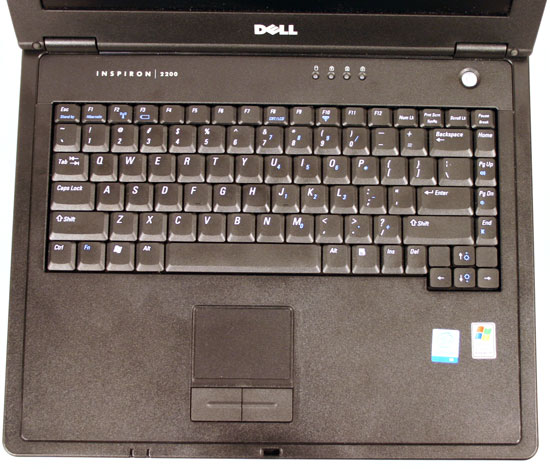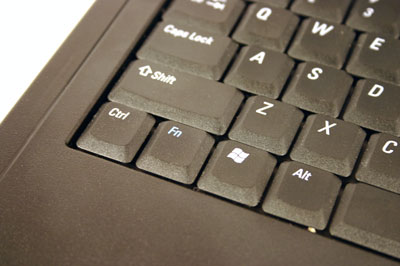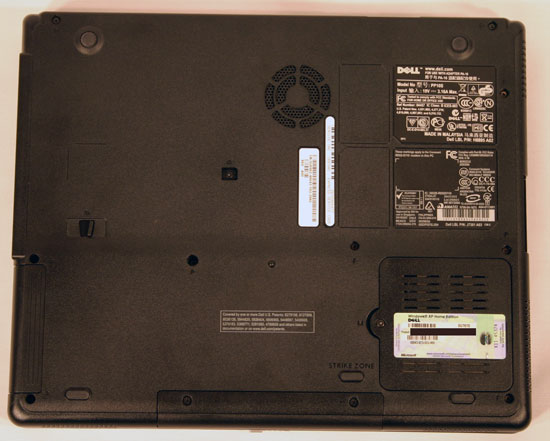$600 Notebook Roundup - Crowning the Affordability King
by Anand Lal Shimpi on November 29, 2005 10:38 AM EST- Posted in
- Laptops
Dell's keyboard is a bit more cramped than the competition. You have about an inch less horizontal space on the Inspiron's keyboard than on the Gateway or Compaq keyboards, which can lead to more typing mistakes. For us, it wasn't too hard getting used to it, but we did feel slightly cramped typing on it and preferred the larger Compaq/Gateway keyboards.
Despite the fact that the Inspiron's Celeron M processor doesn't dynamically adjust its clock speed, the notebook itself doesn't get too far beyond warm on its underside. It will keep your lap slightly warm, but it won't burn you or make you uncomfortable after a lot of typing.
Thanks to the faster Celeron 1.5GHz processor (compared to the 1.4GHz CPU used elsewhere), the Inspiron 2200 that we tested managed to outperform all of the other notebooks. Unfortunately, the Inspiron 2200 also boasted the absolute lowest battery life, which is a real problem for anything that claims to be portable. It's the age old trade off of battery life for performance, and in the case of the Inspiron 2200, it's not one that we're willing to make.
Dell's updated B130 model switches over to a 4-cell lithium-ion battery, as opposed to the large 8-cell NiMH battery that's used in the Inspiron 2200. How this affects battery life will remain to be seen. However, it is worth pointing out that all of Dell's competitors use lithium ion batteries, although they are larger 6-cell designs.


Despite the fact that the Inspiron's Celeron M processor doesn't dynamically adjust its clock speed, the notebook itself doesn't get too far beyond warm on its underside. It will keep your lap slightly warm, but it won't burn you or make you uncomfortable after a lot of typing.

Thanks to the faster Celeron 1.5GHz processor (compared to the 1.4GHz CPU used elsewhere), the Inspiron 2200 that we tested managed to outperform all of the other notebooks. Unfortunately, the Inspiron 2200 also boasted the absolute lowest battery life, which is a real problem for anything that claims to be portable. It's the age old trade off of battery life for performance, and in the case of the Inspiron 2200, it's not one that we're willing to make.
Dell's updated B130 model switches over to a 4-cell lithium-ion battery, as opposed to the large 8-cell NiMH battery that's used in the Inspiron 2200. How this affects battery life will remain to be seen. However, it is worth pointing out that all of Dell's competitors use lithium ion batteries, although they are larger 6-cell designs.










50 Comments
View All Comments
Hacp - Tuesday, November 29, 2005 - link
x200 graphics with/o dedicated memory.If you get x300 graphics with some dedicated memory, it should play some of hte latest games at halfway acceptable settings. Just dont' expect to be playing FPS smoothly though, but RPGs/rts should be fine. Racing should be fine too.
manno - Tuesday, November 29, 2005 - link
meLoneWolf15 - Tuesday, November 29, 2005 - link
Interesting to note that even without Speedstep, the Celeron-M still has better battery life. Then again, didn't Intel change some designs in transistor-switching to make battery performance better even at full speed?One comment, more to notebook manufacturers: Where the heck is my Trackpoint mouse? I can't stand touchpads, which require me to take my fingers off the keyboard to use, when a trackpoint can be used almost simultaneously. I can type 75-80wpm, and don't find touchpads very efficient for this reason (my older but top-of-the-line-when-released Latitude C840 has both devices). Somebody, please bring back the Trackpoint!
Hacp - Tuesday, November 29, 2005 - link
Also, why do you have to take your fingers of the keyboard to use the touchpad? I keep one hand on the keyboard, and one hand on the touchpad when using my computer. Rightclick is tap top right corner, leftclick is tap anywhere on the touchpad that doesn't involve the top right corner.Zorba - Tuesday, November 29, 2005 - link
I too hate touchpads and miss the old mouse sticks. I always rub the touchpad with my arm when typing and usually end up clicking some where I don't want to. It also takes me much longer to navigate with a touchpad and I usually accidently click something because I change the amount of pressure on the pad (I know you can turn the clicking off, but I still don't like the pad). It is a personal preference but I would like to at least be given the chance to pick between the two.matthewfoley - Tuesday, November 29, 2005 - link
Yeah, well I hate the mouse sticks. Who cares.Zorba - Tuesday, November 29, 2005 - link
The point the original poster and I were trying to make is manufacturers should include both devices, which a lot of them used to do.Hacp - Tuesday, November 29, 2005 - link
The battery life difference is most likely due to the ATI chipset and integrated graphics, which uses more power than intel EE.Tamale - Tuesday, November 29, 2005 - link
page 9's link to page 10 is shotTamale - Tuesday, November 29, 2005 - link
nvm :]